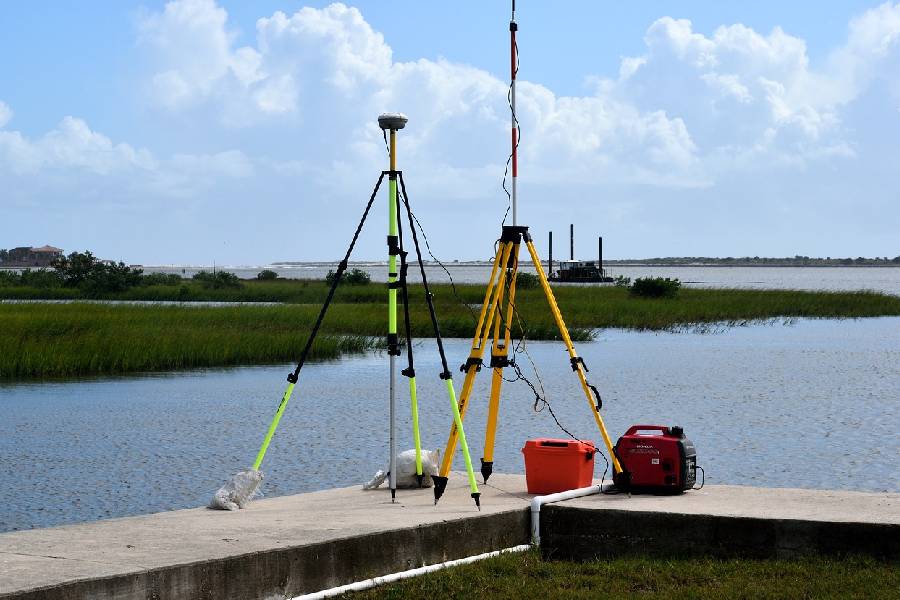In the realm where science and technology converge to protect and nurture our planet, environmental engineers stand as guardians. These diligent professionals navigate the complex web of environmental challenges, from safeguarding our water resources to mitigating air pollution and much more.
But what truly equips them for these monumental tasks? What tools do environmental engineers use? This question opens the door to a world of incredible technologies applied in creative ways.
From classic devices like water quality test kits to advanced systems like geographic information system (GIS) mapping, environmental engineers utilize a diverse range of tools. These tools enable them to solve complex sustainability challenges.
Join us as we provide an overview of must-have equipment in the environmental engineer’s toolkit.

What Tools Do Environmental Engineers Use
The array of equipment used by our environmental engineers is as expansive as the field itself. Their tools allow them to monitor and analyze environmental conditions, model complex systems, design sustainable solutions, and apply their scientific expertise.
Core tools include water quality test kits, air pollution samplers, survey equipment, modeling software, lab equipment, and field monitoring gear.
At Cypress Environment & Infrastructure, advanced technologies like geographic information systems (GIS), remote sensors, and 3D modeling programs are also revolutionizing the work of environmental engineers.
The right tools provide the actionable insights and capabilities needed to develop systems that preserve ecosystems, conserve resources, and protect public health.
Surveying Tools
Environmental engineering is deeply rooted in understanding and assessing the natural environment. A fundamental aspect of this process is collecting accurate data about the land and its features. To achieve this, environmental engineers employ a range of surveying tools, both traditional and modern.
Traditional surveying tools
- Theodolites – These optical instruments measure angles and are essential for tasks like triangulation and land boundary surveys.
- Measuring tapes – Simple yet indispensable, measuring tapes are used to measure distances and create accurate site plans.
Modern surveying tools
- GPS (global positioning system) – GPS technology has revolutionized land surveying. Environmental engineers use GPS devices for precision mapping, enabling them to accurately measure large areas and quickly assess a site’s geographical attributes.
- Total stations – These combine electronic theodolites with electronic distance measurement equipment, offering high accuracy in distance and angle measurements. Total stations are particularly useful in site selection and topographic mapping.
These surveying tools are vital for the initial stages of our environmental engineering projects. They help engineers collect accurate data about the land, which is crucial for site selection and comprehensive land analysis.
By understanding the landscape’s physical characteristics, environmental engineers can make informed choices and develop effective strategies for projects involving land development, infrastructure, or conservation.
Laboratory Equipment
Environmental engineers are often referred to as “lab detectives” because a significant part of their work involves analyzing environmental samples. They use various laboratory tools and equipment to delve into the composition and quality of air, water, soil, and other environmental components.
Common laboratory tools and equipment
- Spectrophotometers – Spectrophotometers measure the absorption of light by a sample, providing information about the concentrations of various substances. They are often used to analyze water quality parameters and pollutant levels.
- Gas chromatographs – Gas chromatographs are instrumental in identifying and quantifying chemicals within complex mixtures. They play a crucial role in detecting and measuring volatile organic compounds, which can be harmful to the environment and human health.
- Mass spectrometers – Mass spectrometers offer high precision in determining the composition of molecules in a sample. They are invaluable for analyzing complex organic compounds in environmental samples by helping identify specific pollutants.
- pH meters – These tools are designed to measure the acidity or alkalinity of a solution. Environmental engineers use pH meters to assess the acidity of water bodies, which is vital for determining water quality and its suitability for various purposes.
- Turbidimeters – Turbidimeters gauge the cloudiness or haziness of a fluid caused by large numbers of individual particles. They are used to measure the turbidity of water, providing insights into its clarity and potential pollution.
- Titration setups – Titration is a common technique for determining the concentration of a substance in a solution. Environmental engineers use titration to assess chemical concentrations in environmental samples, particularly in the context of water treatment and pollution control.
The significance of these laboratory tools is profound. They enable environmental engineers to understand the composition of environmental samples, identify pollutants, measure their concentrations, and assess overall environmental quality.
Laboratory analysis is critical for making informed decisions, implementing pollution control measures, evaluating water quality, and developing sustainable solutions to environmental challenges.
Monitoring Instruments
Environmental engineers rely on an array of monitoring instruments for real-time data collection, allowing them to keep a close eye on various environmental factors. These instruments help maintain and enhance environmental quality. Here’s a glimpse into some of the common monitoring instruments used:
- Air quality monitors – These devices measure concentrations of airborne pollutants such as particulate matter (PM2.5, PM10), volatile organic compounds (VOCs), and gases like ozone (O3) and nitrogen dioxide (NO2). Continuous air quality monitoring is essential for assessing human health risks and supporting compliance with environmental regulations.
- Water quality sensors – Water quality monitoring instruments evaluate parameters like temperature, pH levels, turbidity, and dissolved oxygen. They are used in rivers, lakes, and oceans to track the health of aquatic ecosystems and detect pollution events.
- Weather stations – Environmental engineers often deploy weather stations to gather meteorological data. Parameters monitored include temperature, humidity, wind speed and direction, and barometric pressure. This information is valuable for predicting and responding to weather-related environmental challenges.
- Environmental parameters monitors – These instruments track a wide range of environmental factors, from soil moisture and salinity to radiation levels and noise pollution. By continuously collecting data, environmental engineers can monitor ecological systems, detect changes, and evaluate potential risks.
The role of monitoring instruments extends beyond data collection. They play a crucial part in early warning systems, enabling rapid responses to environmental incidents like chemical spills, water contamination, and air quality issues.
Modeling and Simulation Software
Environmental modeling and simulation software empowers engineers to predict and analyze environmental changes and their consequences. These digital tools provide a virtual platform to test various scenarios and study their impact on the environment.
- HOMER – This software assists in optimizing microgrid design, which can improve energy sustainability in remote or off-grid areas.
- AERMOD – It models the dispersion of air pollutants, aiding in the assessment of industrial emissions and their potential impact on air quality.
- MODFLOW – Environmental engineers use MODFLOW for groundwater flow modeling, supporting decisions regarding water resource management and contamination control.
- OpenStreetMap – As an open-source platform, OpenStreetMap provides geographical data that can be used to analyze and visualize environmental information.
These software tools are essential in making informed decisions for environmental projects. They enable engineers to anticipate the outcomes of different scenarios, assess risks, and optimize strategies for environmental protection and resource management.
Data Analysis and Visualization Tools
Environmental engineers handle vast datasets collected from monitoring instruments and simulations. Data analysis software and visualization tools help extract valuable insights and present findings effectively. Some of the commonly used tools in this category include:
- R – An open-source programming language for statistical analysis and graphical representation of data.
- MATLAB – MATLAB is widely employed for numerical computing, data analysis, and creating complex models.
- Tableau – This data visualization tool aids in creating interactive and shareable dashboards to simplify data presentation to stakeholders.
- GIS mapping software – Geographic information systems (GIS) software like ArcGIS and QGIS are invaluable for creating maps, spatial analysis, and decision-making. They are especially critical in applications like land use planning, habitat conservation, and disaster management.
These tools not only simplify data interpretation, allowing a seamless presentation of findings but also enhance communication between environmental engineers and project stakeholders.
Geographic Information Systems (GIS)
GIS is a necessary tool for environmental engineers, offering powerful capabilities in spatial analysis, and mapping. It plays a pivotal role in numerous environmental projects. Key applications of GIS in environmental engineering include:
- Land use planning – GIS tools help in assessing land use patterns, which is crucial for urban planning, wildlife conservation, and managing protected areas.
- Natural resource management – Environmental engineers use GIS to monitor and manage natural resources such as forests, water bodies, and ecosystems.
- Disaster management – GIS aids in predicting and responding to natural disasters like floods, hurricanes, and wildfires. It supports evacuation planning and damage assessment.
- Habitat conservation – GIS is instrumental in identifying critical habitats for endangered species, helping to develop effective conservation strategies.
A prime example of GIS’s impact is its use in tracking coastal erosion. Environmental engineers use GIS to monitor changes in coastal zones, analyze erosion rates, and plan interventions to protect vulnerable coastlines.

Remote Sensing Technologies
Remote sensing technologies have revolutionized the way environmental engineers gather information, monitor changes, and manage valuable resources. These sophisticated tools and techniques employ a range of devices, from satellites to aerial drones, for a multitude of environmental applications.
Here’s an in-depth exploration of these technologies and their crucial role in environmental engineering:
Satellites
Satellites equipped with various sensors and cameras provide a comprehensive view of the Earth’s surface. They capture data on land use, vegetation, weather patterns, and even atmospheric composition. Environmental engineers leverage satellite data for applications like:
- Deforestation monitoring – Satellites track changes in forest cover, helping to combat illegal logging and protect vital ecosystems.
- Climate change analysis – Continuous monitoring of atmospheric conditions contributes to our understanding of climate change and its impacts.
- Natural resource assessment – Satellite imagery assists in assessing the state of natural resources, such as water bodies, agricultural land, and mineral deposits.
Aerial drones
Unmanned aerial vehicles (UAVs) or drones have gained prominence for their agility and ability to capture high-resolution imagery. Environmental engineers employ aerial drones for a variety of purposes, including:
- Precision agriculture – Drones equipped with specialized sensors can assess crop health, irrigation needs, and soil conditions, optimizing farming practices.
- Ecological studies – Aerial surveys provide valuable data on wildlife populations, habitat quality, and changes in biodiversity.
- Disaster response – Drones are deployed rapidly after natural disasters to evaluate damage and assess the extent of the crisis. They play a vital role in disaster management, especially in challenging terrains.
LiDAR (light detection and ranging)
LiDAR systems employ lasers to measure distances, creating detailed 3D models of landscapes and structures. Environmental engineers use LiDAR for tasks such as:
- Flood modeling – LiDAR data enables the mapping of flood-prone areas and the development of flood modeling for disaster preparedness.
- Urban planning – It aids in creating accurate city models, analyzing building heights, and planning infrastructure developments.
RADAR (radio detection and ranging)
RADAR technology uses radio waves to detect objects and terrain, providing valuable insights into environmental engineering:
- Land subsidence monitoring – RADAR assists in monitoring land subsidence, a critical issue in regions with groundwater extraction and soil compaction.
- Volcano and earthquake studies – It’s used to study geological features, detect volcanic activity, and monitor ground deformation.
Remote sensing technologies excel in disaster management. They are pivotal in monitoring natural disasters such as hurricanes, wildfires, and floods.
Satellite imagery and aerial drones capture real-time data, providing essential information for disaster response and recovery efforts. These tools enhance preparedness, reduce risks, and support quick, effective decision-making.
Emerging Technologies and Tools
Environmental engineering is continually evolving with the integration of cutting-edge technologies. Emerging tools and innovations are reshaping the way our environmental engineers address challenges and provide sustainable solutions. Here are some of the exciting advancements currently shaping the field:
AI and machine learning applications
Artificial intelligence (AI) and machine learning algorithms are invaluable for processing vast amounts of environmental data. These technologies can predict trends, optimize resource management, and detect anomalies in real-time.
For example, AI is being used in water treatment plants to improve efficiency and reduce energy consumption by predicting equipment failures.
Sensor networks and IoT devices
The Internet of Things (IoT) is playing a transformative role in environmental monitoring. Sensor networks and IoT devices are deployed in ecosystems to collect real-time data on parameters like temperature, humidity, pollution levels, and more.
These tools enable environmental engineers to respond promptly to changes, whether in urban air quality monitoring or agricultural irrigation systems.
Blockchain technology for data management
Blockchain’s decentralized and secure nature makes it ideal for managing environmental data. It enhances transparency and trust in processes such as carbon credit trading and supply chain monitoring.
By leveraging blockchain, environmental engineers can ensure the integrity and traceability of data used in environmental management.

Conclusion
Environmental engineers utilize an expansive array of tools, from essential field equipment to cutting-edge technologies. Surveying tools, air and water monitoring devices, laboratory analysis setups, modeling software, remote sensors, and GIS mapping empower environmental engineers to collect data, identify issues, develop solutions, and enact positive change.
While classic tools remain indispensable for tasks like site analysis and field sampling, emerging innovations in AI, IoT, and blockchain are reshaping the future. At Cypress, we stay abreast of these advancements to equip environmental engineers with the best tools for the job.
This article has provided an overview of what tools do environmental engineers use to confront today’s challenges and create a sustainable tomorrow.
As technology progresses, environmental engineers will continue leveraging both time-tested and trailblazing tools to preserve our planet. With the right equipment, environmental engineers hold the key to a greener future.
